In this day and age, we do not expect to see eCommerce shops that do not have gift cards and wish lists features on their websites.
In fact, this has to be one of the unwritten laws governing the world of retail eCommerce.
Regardless of the size of your online shop, your customers’ shopping experience and conversions can be enhanced just by adding those two features.
We have come across case studies where gift cards and wishlists were the difference between an eCommerce shop that has a high conversion rate and one that has low sales.
Folks, gift cards and wish lists are not only reserved for giants like Amazon or eBay –you can also integrate them to your site if you wish to reduce shopping cart abandonment, drive customer engagement, and attract potential customers.
Jakob Nielsen, the guru of Web page usability. describes wishlists and gift certificates as the “anti-pet-food of eCommerce” and he strongly advocates for these features on eCommerce sites.
However, just like any other web feature, gift cards and wish lists have their own downside. If not integrated properly, these two features can create usability problems that may drive your customers’ to your competitors’ doorstep.
Now that you’re here, this article will show you different ways that gift cards and wish lists can increase conversions and revenues on your eCommerce websites. You will also learn the best practices you need to follow in order to avoid usability pitfalls that may emanate from incorporating gift certificates and wish lists.
Defining Gift Certificates and Wish lists
Kevin Graff said it best:
“Gift cards are God’s gift to retail.”
Gift cards are sometimes known as gift certificates, gift vouchers, or gift tokens. You can think of them as prepaid electronic cards that include a monetary value and are valid for a certain period of time (but some do not have an expiration date). A gift certificate can be used to avail some discount or gift at a specific group of stores.
Here’s an illustration of what a gift card/certificate looks like:
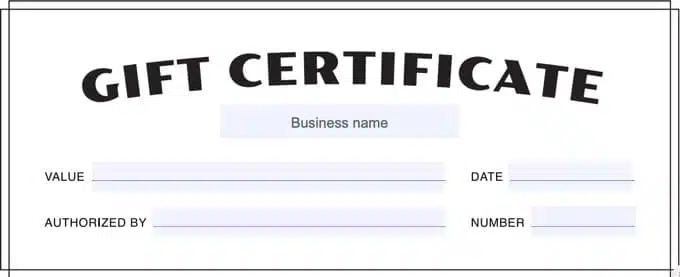
For 12 years running, gift cards have been the most sought after item on consumers’ holiday wishlists. From $318 billion in 2017, the global market for gift cards is expected to reach $506 billion in 2025. That alone should convince you to start selling gift certificates on your eCommerce shop.
On the other hand, a wish list or want list is a personalized collection of goods or services that a person or organization desires.
Shruti Shrivastav thinks that wish lists are not being utilized to their full potential. She also says:
Wishlist mimics an offline shopping assistant. It helps in understanding your preferences, making recommendations, and letting you know when a sale starts and when your size will be back in stock.
Wish lists are handy in every eCommerce website because they allow customers to save desired products to their user accounts, and get back to them when they are ready to make a purchase.
Basically, a wish list on an eCommerce website will look like this:
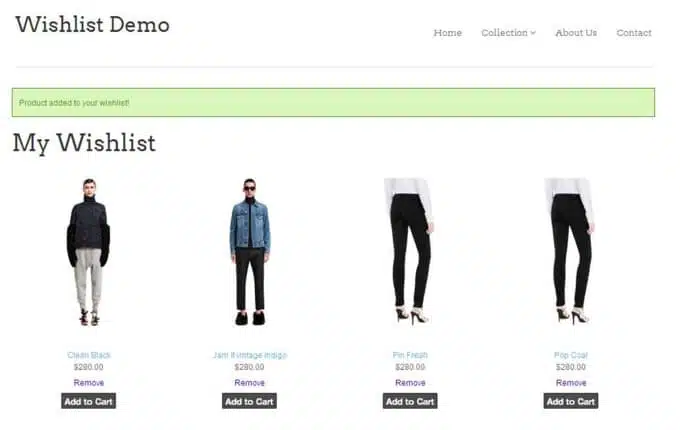
Of course, people save items on the wish list for various reasons. But the most common reasons are:
- When considering buying a product.
- For comparing items they want to buy.
- In order to track price changes.
- Unavailability of size or color in products prompts customers to save the item so as to keep on checking on it.
- Sharing lists with family and friends for special occasions such as birthdays, valentines, and Christmas.
Forthea Interactive Marketing’s Director of Marketing, Holly Gary, believes that wish lists are one of the 15 must-have features for eCommerce websites. She also says:
“What’s better than having customers bookmark items they want and will most likely buy in the future? That’s just gold in the pocket. And a remarketing campaign dream.”
A gift card and wish list feature have ultimate identical goals on eCommerce sites –improving the customers’ shopping experience and increasing conversions. But these two distinct features have wildly different functionalities.
How gift certificates and wish lists increase conversions and revenues of your eCommerce website
No matter the size of your eCommerce store, I can guarantee you that you are leaving a lot of money on the table if your site does not have a gift card and wish list features. As small an element a wish list feature is, it has the power to create a positive customer shopping experience, and this increases conversions and makes customers find their way back to your store.
If you are still not convinced, here is how you can increase conversions and revenue by incorporating gift cards and wish lists on your eCommerce site:
Wishlists allow you to peek into your customers’ minds
In the world of eCommerce marketing, knowing what your customers are thinking about is like holding the book of knowledge. It makes it easy to make better decisions, better allocation of resources, and to come up with an effective marketing message.
Wish Lists have the power to allow you to tap into your customers’ thoughts. I mean if you can see your customers’ personalized collections of products they intend to buy, doesn’t that give you a vivid understanding of their way of thinking?
The data you gather from analyzing your customers’ collection of saved items can help you deliberate on products you should put on discount –products that are saved in wishlists can generate more sales faster.
Also when you track wish lists content, you will not only learn more about the demand for those products, but you can use the information to come up with cross-sell, up-sell, and down-sell ideas.
However, it is important to note that looking into an individual’s wishlist doesn’t provide you with actionable insights –to get valuable results, you’d need to drill into hundreds or thousands of your customers’ wishlists.
So as you analyze different wishlists, chances are high that:
- Depending on the amount, you’d need to analyze more than 200 wishlists in order to get valuable insights.
- A range of different valuable trends begin to emerge, you’d need to capitalize on the findings and optimize your merchandising strategy.
- Different trends will help you to determine the effectiveness of your follow-up email marketing campaigns at the same time shows you which strategy is producing better results.
- The findings will reflect your overall marketing strategy’s effectiveness as you will be able to pinpoint the items that your customers desire to buy.
- The analysis will create an opportunity for further investigations as you’d want to know why your prospects are not buying your products: Is it because the price is high? Are they for promotions or special offers? Or maybe it’s because they need more information about the product.
Having a comprehensive understanding of your customers is the key to achieving increasing conversion rates in every business. And as you know, it becomes easier to convince your customers to make a purchase if you know exactly what’s on their minds.
Wish lists will help you know the items to stock
Unless you are not interested in optimizing your revenue, losing customers because of out of stock items is something that your business should always dodge. The wish list feature provides an opportunity to avoid losing customers. Offer customers an option to save the out of stock product to their wishlist and once the product is back in supply, alert your customers by sending them a personalized email notification.
Short-circuit cart abandonment
The average eCommerce cart abandonment rate is 75.6%. This means that three-quarters of your potential customers will not complete a purchase.
To be honest, that is a huge number by any standards!
Fortunately, this huge eCommerce problem can be lowered by including a wish list function. Wish lists encourage users to hold off on adding products to the cart before they are ready to buy and then allow them to simply pull those items up quickly and whenever they are ready to make an order.
Increased customer retention rate
Alerting your customers that the product they saved on their wishlist is now available is an excellent tactic to retain leads and convince them to make a purchase. Previous studies have shown that returning customers spend 67% more as compared to new users. In this webinar by Brendan Witcher of Forrester, he points out that wish lists can drive open rates as high as 80%, and 5x-10x higher return to purchase.
Increased Subscriptions
Not everyone visits a site with the intention of making a purchase. Some visitors’ objective is to compare prices, while the intention of others is to save an item on the wishlist and wait for it to go on sale. Either way, wish lists can encourage those kinds of prospects to sign up for an account in the event that they see a product they’d like to purchase later on.
Having said that, let’s take a look at how gift certificates can increase conversion rates and revenue on an eCommerce site.
Why should an eCommerce marketer care about gift cards?
Consider this infographic:
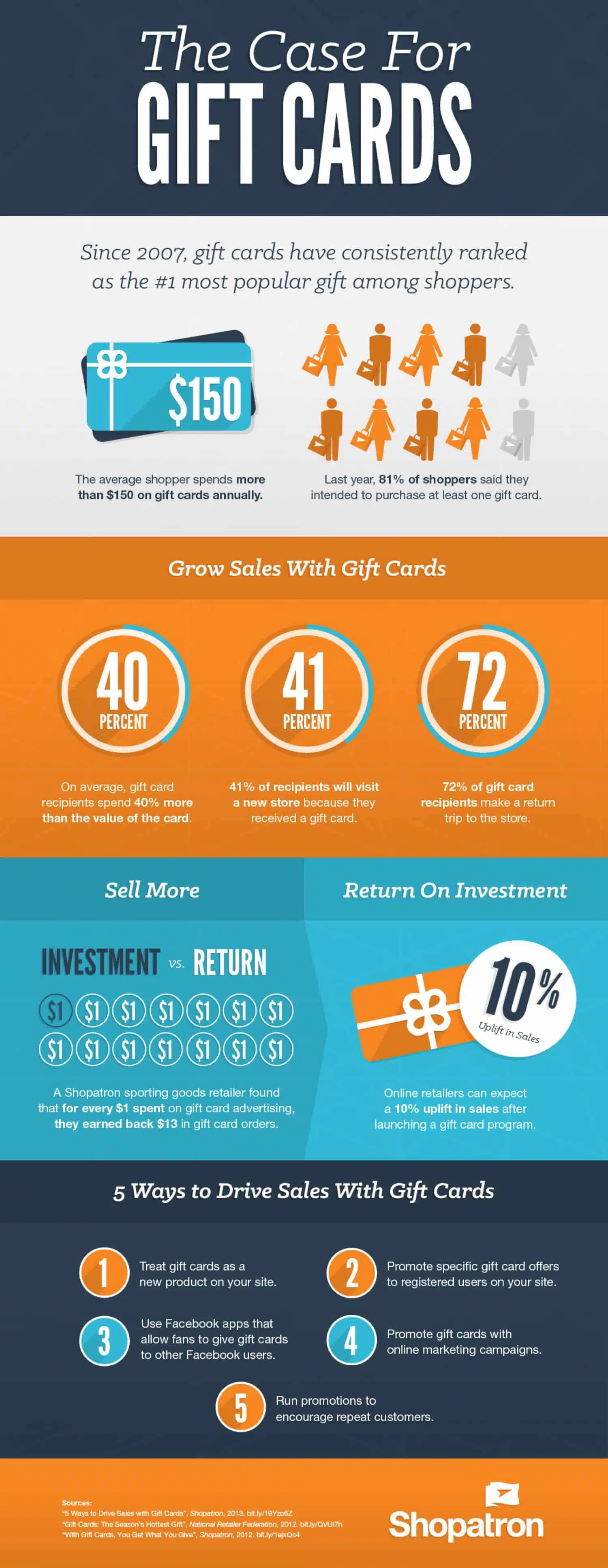
Increased site traffic and brand awareness
Needless to say, when someone receives a digital gift certificate, the next step is to visit the site and look for a product they like. Depending on the experience they had, or the value of the card they might come back to the site to make more purchases until the card is used up. And since shared experiences are the most pleasant experiences – they will likely recruit some friends to join and there is a high possibility of them becoming customers too. It becomes a never-ending cycle.
The same can be said about wish lists, particularly those that are shareable. Allowing your customers to share their wish lists with their friends and family will help you get free traffic with built-in social proof.
Gift card customers spend more money
A gift certificate is a powerful sales tool that boosts revenue when used properly. On average, a gift card recipient spends 20% more than the initial face value of their gift card. This usually happens when they see a product they’d like to buy but the amount in the card doesn’t suffice.
According to a survey by First Data, “respondents who receive either a plastic or a virtual gift card said that they spent an average of $23.41 beyond the original value of the gift card.”
Statistics also reveal that customers with a gift card are 2.5 times more likely to purchase products at full price than those who buy in cash. Even before any product has been purchased, when you sell gift certificates you will receive your money in advance –and this is something that will help you take care of all business-related expenses.
Attracting New Customers
While you can count on wish lists to increase your customer retention rate, you can depend on gift cards to lure customers to your webshop.
After one receives a gift certificate from a friend or family member, he/she will have to visit the shop in order to redeem the voucher.
If your shop provides a positive customer shopping experience to that person, chances are they will come back to purchase again and again. In fact, statistics tell us that 55% of gift card recipients make more than one trip to the business to deplete the value of their card.
So if you think about it, gift certificates serve as a cost-effective and yet effective way of advertising.
Benefiting from unused cards
This sounds wrong to say, but it’s true: eCommerce shops can actually take advantage of gift cards that go unused. Despite the 2009 Credit Card Act regarding credit card expiration dates, studies show that $3 billion worth of gift cards go unused each year.
How is that even possible?
Most eCommerce shops offer gift certificates that have an expiration date. So once the expiration date passes, customers can no longer use the card to make a purchase and unspent money is sent back to the retailer. But whether a gift card is used or not used, it’s always a win-win scenario for eCommerce shops.
Generate buzz around a specific season
Whether it’s Valentine’s Day, Mother’s Day, or even on Halloween, people are always on the look for gift ideas. And if you have an eCommerce site, you can always latch on to such events and promote gift certificates that suit the occasion. The best part is that: digital gift cards are easy to customize as compared to plastic gift certificates that you will have to pre-order before a targeted season begins. The fact that all you have to do is to design –shows that electronic gift cards are cost-efficient.
Offering gift certificates on a site should never be a hard thing to do, here’s how you can go about it:
Gift cards and wish list best practices on eCommerce websites
The more creative you get with your gift card and wish list marketing, the more return you’ll see from them. Here are a few ways you can up your gift card and wish list game:
Gift Cards best practices:
Use electronic or emailed gift certificates
Instead of using paper or plastic versions of gift certificates, it’s best if you’d opt for emailed or electronic gift certificates as they are cost-efficient and they will allow you to target a wide range of customers that include last-minute shoppers (literally on Valentine’s day, Christmas day, etc.). Electronic gift certificates make it easy for shoppers since all they have to do is to copy and paste their codes directly online into the website. This is something that is impractical in paper gift certificates as they may cause your customers to face manual data entry problems.
Gift Certificate placement
Some businesses may prefer pop-ups, a tab on the main navigation bar, or even an option on the site’s footer, but creating a gift certificate page makes the whole process fast and smooth for your shoppers. You should make it more visible for your visitors by placing a link to the gift certificate page just below each product (in the product category page) and on the shipping information page.
A good example of an eCommerce site that has a gift certificate/card page is Amazon:
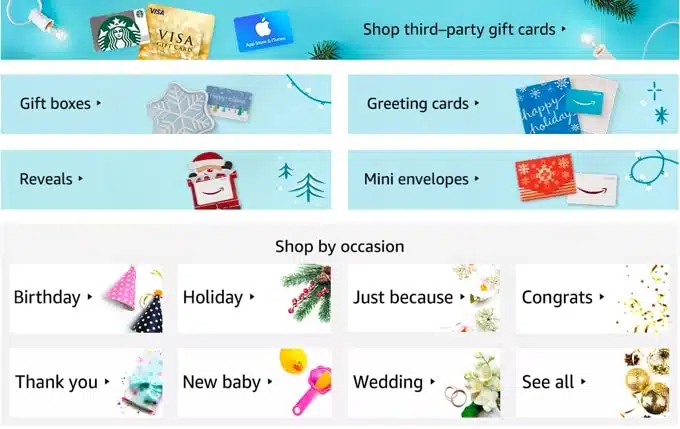
Take note of all those types of gift cards offered by Amazon. They almost all seasons and different occasions. If you’re to scroll upwards on that same page, you’d notice that they offer an option to print or email the preferred gift card.
Promote free shipping for gift certificates buyers
In most cases, customers who buy gift certificates do not want their recipients to incur any costs, especially the product’s shipping cost. Suppose you have a free shipping threshold, you should consider promoting that in the gift certificate prices. Free shipping has proved to be an effective tool for promoting a site and it encourages customers to spend more.
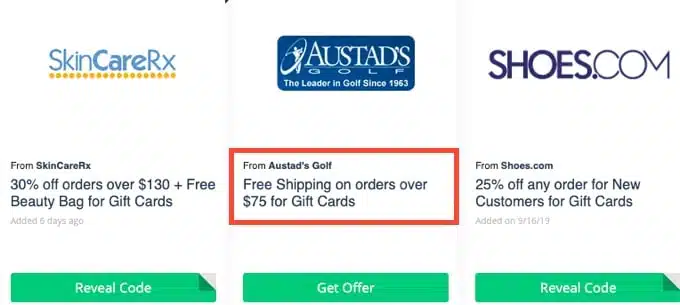
As you can see from the above image taken from Offers.com, gift cards that are $75 and more come with free shipping. This encourages customers to go beyond the $75 gift card.
Provide gift certificates without expiration dates
Whether you offer plastic gift cards, paper gift certificates, or electronic gift cards, they should have no expiration dates, or they should at least be valid for 5 years. After forking out money to acquire a gift card, it’s frustrating to discover that your recipient has a short time frame before it lapses.
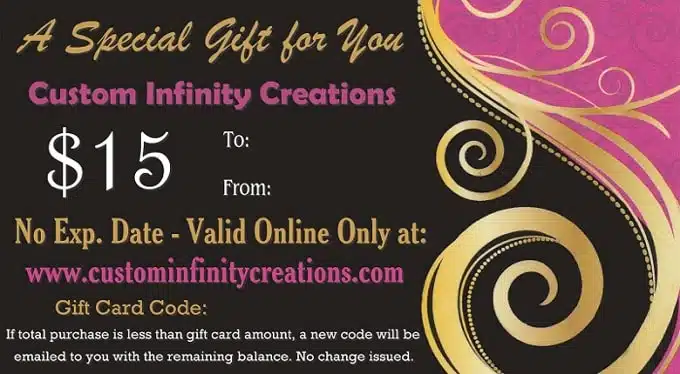
If the recipient doesn’t use the card within 12 months, some businesses charge inactivity fees. Another advantage you may want to consider is to email unused gift certificate recipients with promotions.
Use a format with a high open-rate on electronic gift certificates emails
If the recipient of the electronic gift certificate has never visited your site before, they might ignore the email and it will go to their junk folder. But, they will recognize, and open email that comes from their friends or family members. This is the reason why you should also include a gift giver’s name along with your company name in the subject line of the email.
Use a clear CTA
To earn the attention of the recipient, there is a great need to use a clear call to action that lets the recipient know that they have received a gift certificate. In your CTA button, you can include (1) the gift certificate’s amount, (2) a button or a link to start shopping, (3) details about the validity of the card, (4) your customer service email and phone number in case they have questions.
Send confirmation of the remaining balance.
Suppose the recipient does not spend all of the gift certificate amounts in one go, it’s important to constantly remind your recipients if they have money left, as this can prompt them to return to your site to spend it. You can send a statement of the remaining balance as a confirmation to the recipient’s email.
Wish lists best practices:
- Place the wishlist in a position that is easy to locate on your site.
- Test your wishlist on mobile devices so as to make sure that they are mobile-friendly.
- Allow customers to customize and rename their wishlist. One customer can have multiple lists with different names.
- Make your lists shareable so that your customers can send wishlists to family members and friends.
- When customers spend some time on a product page or when they are about to exit the product page, you can consider utilizing popups so as to encourage the use of wishlists.
But…lookout for Gift Cards and Wishlists UX pitfalls
Wish lists and gift certificates may be good for luring new users to your site, but – if they are not carefully incorporated – they may cause a lot of UX problems.
As marketers, we often view gift cards and wishlists as a smart persuasive tool that introduces the site to a new set of prospects, right?
But if you think about it, this same advantage presents a tremendous challenge to new users, and it is one of the usability pitfalls that users should try to avoid.
Recipients of gift cards are more likely to be first-time users on your site, and they probably don’t know how the site works. Some of these new users might have never heard of your brand name before and this means that their behavior on the site is likely going to be different. Any small glitches in terms of site functionality can easily lead to frustration.
The most popular usability issues associated with gift cards and wish lists are poorly designed email notifications that are not persuasive enough. Generally, people have a tendency of ignoring email notifications that are not compelling.
While it’s true that gift recipients often spend more than the certificate value, they only do so when they feel like the site is indeed trustworthy.
Always disclose shipping and handling, sales taxes, and some other related things before you even ask these new users for their personal information. New users have to be equipped with the necessary information as this can help to build trust.
Smart eCommerce managers know that each customer is different and due to this, they have to accommodate a broader audience by providing a great user experience across the site. You may be selling fashionable female wear, a wishlist shopper might be a male who may be buying a gift card for his wife. This, therefore, reflects that your product pages and checkout process must cater to first-time shoppers outside your targeted customers.
Conclusion: Embrace gift cards and wish lists in your testing strategy
Sometimes it’s not the most obvious A/B tests that drive more conversions and increase revenue. Instead, it can be the unconventional tests – like gift cards and wish lists testing – that prove to be the most valuable. And also considering that gift cards, and wish lists can create usability problems on your website –these two functions should be tested before they are permanently implemented on any eCommerce websites.



